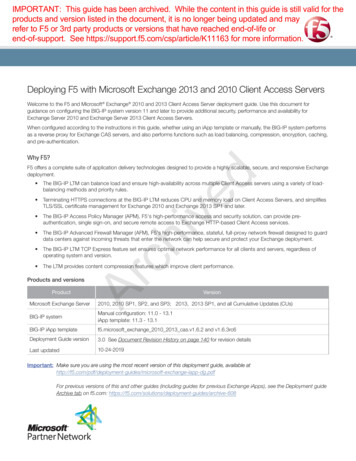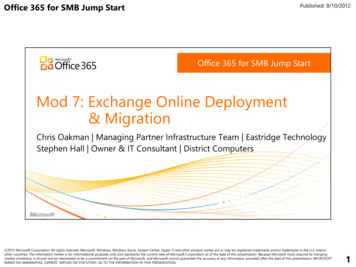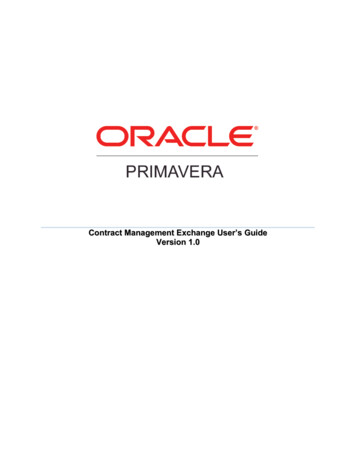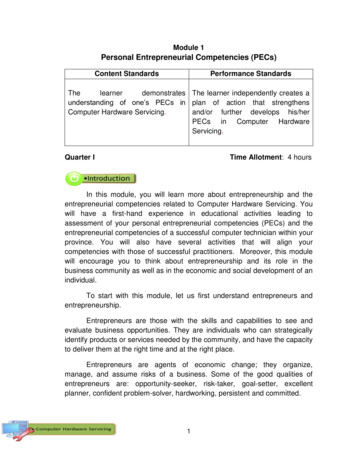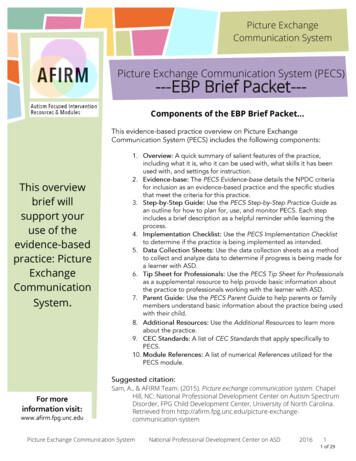
Transcription
Picture ExchangeCommunication System(PECS)Picture Exchange Communication System (PECS)---EBP Brief Packet---Components of the EBP Brief Packet This overviewbrief willsupport youruse of theevidence-basedpractice: PictureExchangeCommunicationSystem.8.For moreinformation visit:www.afirm.fpg.unc.eduSam, A., & AFIRM Team. (2015). Picture exchange communication system. ChapelHill, NC: National Professional Development Center on Autism SpectrumDisorder, FPG Child Development Center, University of North Carolina.Retrieved from tion-systemPicture Exchange Communication SystemNational Professional Development Center on ASD201611 of 29
Picture ExchangeCommunication System(PECS)What is Picture Exchange Communication System?Similar to sign language and picture boards, PECS is an augmentative and alternativecommunication (AAC) system.4 AAC systems are used to help individuals who do not have typicalverbal skills to communicate with others. PECS is a behavior based intervention that teaches thelearner to use visual-graphic symbols to communicate with others.2, 5Learners with ASD are taught to give a picture or graphic symbol of a desired item to acommunicative partner in exchange for the actual item through a six phase process. Each phaseof PECS instruction builds upon the previous phase.Evidence-baseBased upon the recent review, Picture Exchange Communication System meets the evidencebased practice criteria set by NPDC with 4 single case design studies and 2 group design studies.The practice has been effective for preschoolers (3-5 years) to middle school learners (12-14years) with ASD. Evidence-based practices (EBP) and studies included in the 2014 EBP reportdetailed how Picture Exchange Communication System can be used effectively to address: social,communication, and joint attention outcomes.How is PECS Being Used?All team members can use the PECS procedures. However, it is recommended that thoseinterested receive professional training. This module is not intended to take the place of trainingand resources on PECS provided by Pyramid Educational Consultants, Inc. (the developers andmarketers of the PECS system). Please visit the website: www.pecsusa.com for information onresources and training. The information presented in this module should be implemented underthe supervision of a trained professional.For moreinformation visit:www.afirm.fpg.unc.eduPicture Exchange Communication SystemNational Professional Development Center on ASD201622 of 29
Picture ExchangeCommunication System(PECS)---Evidence-base for Picture ExchangeCommunication System--The National Professional Development Center on ASD has adopted the following criteria to determine if apractice is evidence-based. The EBP Report provides more information about the review process (Wong etal., 2014).Efficacy must be established through high quality, peer-reviewed research in scientific journals using: randomized or quasi-experimental design studies (two high quality experimental or quasiexperimental group design studies), single-subject design studies (three different investigators or research groups must haveconducted five high quality single subject design studies), or combination of evidence [one high quality randomized or quasi-experimental group design studyand three high quality single subject design studies conducted by at least three differentinvestigators or research groups (across the group and single subject design studies)].--OVERVIEW-Picture Exchange Communication System (PECS) is used to teach learners with ASD with limited functionalcommunication skills to initiate communicative exchanges and interactions within a social context. PECSmeets the evidence-based practice criteria with 4 single case design studies and 2 group design studies. Thepractice has been effective with learners in preschool (3-5 years) to middle school (12-14 years). Studiesincluded in the 2014 EBP report detailed how PECS can be used effectively to address: social,communication, and joint attention outcomes.In the table below, the outcomes identified by the evidence base are shown by age of participants.Early Intervention(0-2)Preschool(3-5)Elementary(6-11)No e(12-14)High(15-22)No studiesCommunicationJoint AttentionPicture Exchange Communication SystemNational Professional Development Center on ASD201613 of 29
Picture ExchangeCommunication System(PECS)Early intervention (0-2 Years)No studiesPreschool (3-5 years)*Carr, D., & Felce, J. (2007). The effects of PECS teaching to Phase III on the communicative interactions betweenchildren with autism and their teachers. Journal of Autism and Developmental Disorders, 37(4), 724-737. doi:10.1007/s10803-006-0203-1Dogoe, M. S., Banda, D. R., & Lock, R. H. (2010). Acquisition and generalization of the picture exchange communicationsystem behaviors across settings, persons, and stimulus classes with three students with autism. Education andTraining in Autism and Development Disabilities, 45(2), 216-229.Jurgens, A., Anderson, A., & Moore, D. W. (2009). The effect of teaching PECS to a child with autism on verbal behaviour,play, and social functioning. Behaviour Change, 26(1), 66. doi: 10.1375/bech.26.1.66Elementary (6-11 years)*Ali, E., MacFarland, S. Z., & Umbreit, J. (2011). Effectiveness of combining tangible symbols with the Picture ExchangeCommunication System to teach requesting skills to children with multiple disabilities including visualimpairment. Education and Training in Autism and Developmental Disabilities, 46(3), 425.Angermeier, K., Schlosser, R. W., Luiselli, J. K., Harrington, C., & Carter, B. (2008). Effects of iconicity on requesting withthe Picture Exchange Communication System in children with autism spectrum disorder. Research in AutismSpectrum Disorders, 2(3), 430-446. doi: 10.1016/j.rasd.2007.09.004*Carr, D., & Felce, J. (2007). The effects of PECS teaching to Phase III on the communicative interactions betweenchildren with autism and their teachers. Journal of Autism and Developmental Disorders, 37(4), 724-737. doi:10.1007/s10803-006-0203-1Howlin, P., Gordon, R. K., Pasco, G., Wade, A., & Charman, T. (2007). The effectiveness of Picture ExchangeCommunication System (PECS) training for teachers of children with autism: a pragmatic, group randomisedcontrolled trial. Journal of Child Psychology and Psychiatry, 48(5), 473-481. doi: 10.1111/j.14697610.2006.01707.xMiddle (12-14 years)*Ali, E., MacFarland, S. Z., & Umbreit, J. (2011). Effectiveness of combining tangible symbols with the Picture ExchangeCommunication System to teach requesting skills to children with multiple disabilities including visualimpairment. Education and Training in Autism and Developmental Disabilities, 46(3), 425.High (15-22 years)No studies* Research which included participants in multiple age ranges.Picture Exchange Communication SystemNational Professional Development Center on ASD201624 of 29
Picture Exchange Communication System (PECS)---Step-by-Step Guide--BEFORE YOU START This practice guideoutlines how to planfor, use, and monitorthe Picture ExchangeCommunication Systempractice.Keep in mind that PECSteacher the learner touse visual-graphicsymbols tocommunicate withothers.Each of the following points is importantto address so that you can be sure the selected EBPis likely to address the learning needs of yourstudent.Have you found out more information about. . .? Identified the behavior Collected baseline data through directobservation Established a goal or outcome that clearlystates when the behavior will occur,what the target skill is, and how theteam will know when the skill ismastered If the answer to any of these is “no,” review theprocess of how to select an EBP.For more information visit:www.afirm.fpg.unc.eduPicture Exchange Communication SystemNational Professional Development Center on ASD201615 of 29
Now you are ready to start Step 1: PECS PlanningThe planning step how to conduct a reinforcer sampling and prepare materials for PECS.1.1 Receive PECS training from a certified PECS TrainingThis module is not intended to take the place of training provided by Pyramid Educational Consultants, Inc.For information on training and resources provided, visit the Pyramid Educational Consultants, Inc. website athttp://www.pecsusa.com.1.2 Establish performance criteria for program goalsA minimum of two adults are needed to implement PECS. One adult is identified as the “helper” and the otheradult as the “communicative partner”.1.3 Conduct a reinforcer samplingReinforcers are needed for using PECS. A reinforcer sampling can be used to identify reinforcers forindividual learner.The PECS Reinforcer Sampling found in the Resource section will help you identify potential reinforcersto use with the learner.1.4 Conduct assessmentsDetermine the learner’s current communication skills. The information collected through assessments, willhelp team members determine target skills for PECS training (for example, requesting, initiating interactions)and types of prompts that can be used to facilitate communicative exchanges.1.5 Prepare communication pictures/symbols and booksNo specific pictures or symbols are required for PECS. Select the pictures/symbols that are the easiest tocreate and use. A designated communication book is needed to store all commonly used pictures/symbols.Plan for creating at least two copies of the communication book for use when the learner begins using PECSacross settings and with different communicative partners.Picture Exchange Communication SystemNational Professional Development Center on ASD201626 of 29
Picture ExchangeCommunication SystemSTEP-BY-STEPStep 2: Using PECSThis section describes the process of using PECS and each phase of instruction.2.1 Implement Phase 1: Teaching the physically assisted exchangeThe goal of Phase 1 is for the learner with ASD to look at, reach for, pick up, and hand the picture/symbol tothe communicative partner. To accomplish this goal, address the following: Arrange the training environment by creating opportunities for learning should be available inboth a structured and unstructured environment. In a structured training environment, thelearner with ASD should be across from the communicative partner, with a helper seated behindor beside the learner to assist in developing the desired actions. To help learners generalize theuse of newly acquired skills across settings, activities, and people, PECS training can occur inunstructured environments such as during center time, recess, or lunch.Helper physically prompts the learner’s communicative exchange with communicative partner.During this stage, no verbal prompts are used with the learner to increase the learner’sindependence and reduce the learner’s reliance upon others during communicative exchanges.Reward learner with reinforcer (desired item) once the learner gives the picture/symbol to thecommunicative partner AND the communicative partner labels the item.Gradually reduce the amount of assistance so that few or no prompts are needed for the learnerto initiate and complete an exchange by using backward chaining. As the learner becomes moreindependent during communicative exchanges and less physical assistance from the helper isrequired, the communicative partner can begin to fade the open-hand prompt.The learner meets basic skills of Phase 1 and is ready to move to Phase 2 when the learner is:o Reaching for the high-interest itemo Picking up the picture/symbol of the item,o Handing the picture/symbol to the communicative partnero Acquiring high interest item2.2 Implement Phase 2: Expanding spontaneityThe goal of Phase 2 is for the learner with ASD to increase spontaneity and generalization of the pictureexchange. To accomplish this goal, address the following: Increase the number and variety of reinforcer items to prevent satiation. The learner with ASD should exchange pictures/symbols with more communicative partnersselected from individuals with whom the learner interacts on a regular basis. To increase generalization of the communicative exchange, instruction should occur in a varietyof natural environments such as home, school, and community. The learner should seek out the communication book in order to request items from a partner.To expand the spontaneity of communicative exchanges, use the following two traveling activities:1) increase the distance to the communicative partner and 2) increase the distance from thecommunication book. The learner meets skills of Phase 2 and is ready to move to Phase 3 when the learner is:o Traveling to communicative partner (distance)o Traveling to communication book (distance).Picture Exchange Communication SystemNational Professional Development Center on ASD201637 of 29
Picture ExchangeCommunication SystemSTEP-BY-STEPStep 2: Using PECS (continued)2.3 Implement Phase 3: Simultaneous discrimination of picturesThe goal of Phase 3 is for the learner to attend to the pictures/symbols in order to discriminate betweenthem. To accomplish this goal, address the following: When beginning Phase 3, the communication book will only include two pictures/symbols. Onepicture should be a known, highly reinforcing item or an item appropriate for the situation. Thesecond picture is a non-preferred or unrelated item. It is very important to reinforce the learner’sselection of the correct picture as soon as it happens. If learners do not learn this skill as quickly, they will need specific instruction. For these learners,use the 4-step error correction procedure. Once the learner can discriminate between two pictures/symbols, additional pictures/symbolsare introduced to allow for the learner to request from multiple picture/symbol options. Use correspondence checks to ensure that the learner is requesting and taking the item forwhich he or she is asking. The learner meets skills of Phase 3 and is ready to move to Phase 4 when the learner is:o Independently discriminating between 12 to 20 pictures/symbolso Accurately discriminating between 3 or pictures/symbols presented as optionso Independently traveling to and from communication book to initiate exchange.2.4 Implement Phase 4: Building sentence structureThe goal of Phase 4 is for the learner to spontaneously make requests using simple sentence structure. Toaccomplish this goal, address the following: Introduce the sentence strip to the learner by placing the “I want” symbol on the left side ofsentence strip, Communicative partner guides learner to place the selected picture/symbol nextto “I want” symbol on sentence strip. After the learner removes the sentence strip (withassistance if needed) and hands it to the communicative partner, the communicative partnerreads the sentence pointing to each symbol/picture. Use backward chaining to fade assistance. After the communicative partner reads, “I want,” and before naming the requested item, thecommunicative partner should pause to promote verbalization. The learner meets skills of Phase 4 and is ready to move to Phase 5 when the learner is:o Placing the “I want” symbol on the strip.o Placing picture/symbol on stripo Exchanging the strip with communicative partnero Pointing to pictures/symbols.Picture Exchange Communication SystemNational Professional Development Center on ASD201648 of 29
Picture ExchangeCommunication SystemSTEP-BY-STEPStep 2: Using PECS (continued)2.5 Implement Phase 5: Responding to “What do you want?”The goal of Phase 5 is for the learner to increase initiations and for the learner to answer the question, “Whatdo you want?” To accomplish this goal, address the following: To begin teaching the learner to respond to the question, “What do you want?” use a 0-seconddelay. Simultaneously point to the “I want” card and ask the learner “What do you want.” As the learner demonstrates ability to complete the sentence strip and the exchange, increasethe interval of the delay. The communicative partner should encourage the learner to completethe exchange prior to the point prompt. The learner meets skills of Phase 5 and is ready to move to Phase 6 when the learner is:o Responding and requesting without promptso Beating the prompt for the delay interval used.2.6 Implement Phase 6: Commenting in response to a questionThe goal of Phase 6 is for the learner to use labeling and naming. To accomplish this goal, address thefollowing: Add a new symbol to represent the concept of “I see” to the communication book. Introduce commenting in response to the question, “What do you see?” by holding up a selecteditem and asking the question. The communicative partner physically assists learner in picking up“I see” symbol and placing it on the sentence strip. The communicative partner waits 5 seconds, Iflearner places the picture/symbol on sentence strip and gives it to communicative partner,provide praise and a reinforcer (not item being held by communicative partner. If the learnerdoes not, the communicative partner should provide physical assistance. Gradually addpictures/symbols and items for the learner to discriminate among. Two teach differentiated responses, add the question “What do you want?” Then add otherquestions such as “What do you hear?” or “What do you have?” To encourage a learner to comment without being questioned first, create interestingenvironmental events and fade questions. The learner has acquired the needed skills for Phase 6 when the learner is:o Making spontaneous requestso Making spontaneous comments.Picture Exchange Communication SystemNational Professional Development Center on ASD201659 of 29
Picture ExchangeCommunication SystemSTEP-BY-STEPStep 3: Monitoring PECSThe following process describes how the use of PECS can be monitored and how to adjust your plan based on thedata.3.1 Collect data on target behavior/skillsBy collecting data on target behaviors and skills, team members are able to determine if the learner is makingprogress. To purchase these resources, visit the Pyramid Educational Consultants website athttp://www.pecsusa.com.3.2 Determine next steps based on learner progressCollecting data will help team members determine if the learner is ready to move to the next phase of PECS.If the learner is making progress based upon data collected, team members should continue to use PECS.If the learner with ASD is not showing progress, ask yourself the following questions: Do the preferred items need to be changed? Do additional preferred items need to be added? Are selected reinforcing items motivating to the learner? Is the correct level of prompting or physical assistance being used? Does the learner need to address skills acquired in a previous Phase? Is PECS being used with fidelity? (Use the PECS Implementation Checklist to determine fidelity.) Has a team member been trained to use PECS? (See Pyramid Educational Consultants websitefor training opportunities at http://www.pecsusa.com.)If these issues have been addressed and the learner with ASD continues not to show progress, considerselecting a different evidence-based practice to use with the learner with ASD.Picture Exchange Communication SystemNational Professional Development Center on ASD2016610 of 29
Picture Exchange Communication System (PECS)---Implementation Checklist--Before youstart:Have you Receive PECS training from a certified PECS trainerIdentify adults who will participate in PECS and train as neededConduct a reinforcer samplingConduct assessmentsPrepare communication pictures/symbols and booksImplement Phase 1: Teaching the physically assisted exchange Arrange the training environment Helper physically prompts the learner’s communicative exchange withcommunicative partner Reward learner with reinforcer Thin physical assistance and open-hand prompt Determine if learner meets basic skills of Phase 1 to move to Phase 2Implement Phase 2: Expanding spontaneity Increase number and variety of reinforcers Increase number of communicative partners Conduct training in a variety of environments Encourage learner to seek communication book through traveling activities Determine if learner meets skills of Phase 2 to move to Phase 3Implement Phase 3: Simultaneous discrimination of pictures Reinforce selection of correct picture to teach discrimination between two pictures Teach discrimination through correction procedure Increase number of pictures in display Conduct correspondence checks Determine if learner meets skills of Phase 3 to move to Phase 4Implement Phase 4: Building sentence structure Introduce sentence structure to learner Promote verbalization Determine if learner meets skills of Phase 4 to move to Phase 5Implement Phase 5: Responding to “What do you want?” Introduce the question, “what do you want?’ using a zero-second delay Increase delay interval for the point prompt Determine if learner meets skills of Phase 5 to move to Phase 6Implement Phase 6: Commenting in response to a question Prepare needed materials Introduce commenting in response to a question Teach differentiated responses to questions Teach spontaneous commenting Determine if learner meets skills of Phase 6Collect data on target behaviors/skillsDetermine next steps based on learner progressPicture Exchange Communication SystemNational Professional Development Center on ASD2016111 of 29
Picture ExchangeCommunication System---PECS Phase Guide---For more information visit:www.afirm.fpg.unc.edu (AFIRM Modules)www.pecsusa.com (PECS Training & Resources)Picture Exchange Communication SystemNational Professional Development Center on ASD2016112 of 29
Picture ExchangeCommunication System---PECS Data Collection---PhaseCollect Data On: Record skills used during the communicative exchange (i.e., pickingup, reaching, releasing)Record types of prompts needed to complete communicativeexchange (e.g., full physical, partial)Record if the learner traveled to communicative partnerRecord distance learner traveled to communicative partnerRecord if the learner traveled to communication bookRecord distance learner traveled to communication bookRecord items requested (at least four different items)Record number of pictures the learner can independentlydiscriminate (between 12 to 20)Record number of pictures the learner can accurately discriminateamong (between 3 to 4)Record distance learner traveled to communication bookRecord if learner places “I want” on sentence stripRecord if learner places picture/symbol on sentence stripRecord exchanges of sentence strip with communicative partnerRecord if learner points to pictures/symbolsRecord delay interval usedRecord if learner answers questionRecord if learner beat promptRecord if learner responds to question “What do you see?”Record if learner responds to question “What do you want?”Record if learner makes a spontaneous requestRecord if learner makes a spontaneous commentFor more information visit:www.afirm.fpg.unc.edu (AFIRM Modules)www.pecsusa.com (PECS Training & Resources)Picture Exchange Communication SystemNational Professional Development Center on ASD2016113 of 29
Picture ExchangeCommunication System---PECS Phase 1 Checklist--- For more information visit:www.afirm.fpg.unc.edu (AFIRM Modules)www.pecsusa.com (PECS Training & Resources)Picture Exchange Communication SystemNational Professional Development Center on ASD2016114 of 29
Picture ExchangeCommunication System---PECS Phase 2 Checklist--- For more information visit:www.afirm.fpg.unc.edu (AFIRM Modules)www.pecsusa.com (PECS Training & Resources)Picture Exchange Communication SystemNational Professional Development Center on ASD2016115 of 29
Picture ExchangeCommunication System---PECS Phase 3 Checklist--- For more information visit:www.afirm.fpg.unc.edu (AFIRM Modules)www.pecsusa.com (PECS Training & Resources)Picture Exchange Communication SystemNational Professional Development Center on ASD2016116 of 29
Picture ExchangeCommunication System---PECS Phase 4 Checklist--- For more information visit:www.afirm.fpg.unc.edu (AFIRM Modules)www.pecsusa.com (PECS Training & Resources)Picture Exchange Communication SystemNational Professional Development Center on ASD2016117 of 29
Picture ExchangeCommunication System---PECS Phase 5 Checklist--- For more information visit:www.afirm.fpg.unc.edu (AFIRM Modules)www.pecsusa.com (PECS Training & Resources)Picture Exchange Communication SystemNational Professional Development Center on ASD2016118 of 29
Picture ExchangeCommunication System---PECS Phase 6 Checklist--- For more information visit:www.afirm.fpg.unc.edu (AFIRM Modules)www.pecsusa.com (PECS Training & Resources)Picture Exchange Communication SystemNational Professional Development Center on ASD2016119 of 29
Picture ExchangeCommunication System---PECS 4-Step Error Correction--- Communicative partneropens hand neardesired picture/symbolor uses aphysical/gesture promptto exchange thecorrect (desired)picture/symbol. Get the learner to look atthe correctpicture/symbol bypointing to or tappingcorrect picture. Entice with bothitems again. Turn thecommunication bookaway or switch to aknown task to distractthe learner.Enlarge picture/symbol of the relevant object to be larger than the picture/symbol of the non-preferredpicture/symbolUse color picture/symbol of relevant objects to contrast black-and-white pictures of non-preferred/irrelevant objectHighlight the picture/symbol of relevant object with a magic markerUse a blank card as the other picture in the displayMake the picture/symbol of the relevant object 3-dimensional by attaching it to a blockPlace the picture/symbol of relevant object closer to where you are holding the desired object.For more information visit:www.afirm.fpg.unc.edu (AFIRM Modules)www.pecsusa.com (PECS Training & Resources)Picture Exchange Communication SystemNational Professional Development Center on ASD2016120 of 29
Picture ExchangeCommunication System---PECS Reinforcer Sampling--- For more information visit:www.afirm.fpg.unc.edu (AFIRM Modules)www.pecsusa.com (PECS Training & Resources)Picture Exchange Communication SystemNational Professional Development Center on ASD2016121 of 29
Picture Exchange Communication System (PECS)---Tip Sheet for Professionals---Picture ExchangeCommunicationSystemPECSPicture Exchange Communication System is an evidence-based practice for children and youth withautism spectrum disorder (ASD) from 3 to 14 years ofage.is a behaviorally based intervention that teaches thelearner to use pictures/symbols to communicate withothers.Why Use? Some learners with ASD might not develop typical verbaland nonverbal communication skills.PECS can be used to develop a system of communicationand promote speech development.PECS can be used to teach learner’s with limitedfunctional communication skills to initiate communicativeexchanges and interactions within a social context.TIPS: TIPS:Outcomes The evidence-base for PECS supports the use of thispractice to address the outcomes below: 1)No studiesSocialSocialCommunicationCommunicationJoint AttentionPicture Exchange Communication SystemMiddle(12-14)High(15-22)No studiesCommunication National Professional Development Center on ASD 2016122 of 29
Picture Exchange Communication System (PECS)---Tip Sheet for Professionals--STEPS FOR This tip sheet wasdesigned as asupplementalresource to helpprovide basicinformation aboutthe practice.For moreinformation visit:www.afirm.fpg.unc.edu Picture Exchange Communication System1Receive PECS training from a certified PECS trainerIdentify adults who will participate in PECS and train as neededConduct a reinforcer samplingConduct assessmentsPrepare communication pictures/symbols and books2.1 Implement Phase 1: Teaching the physically assisted exchange Arrange the training environment Helper physically prompts the learner’s communicative exchange with communicative partner Reward learner with reinforcer Thin physical assistance and open-hand prompt Determine if learner meets basic skills of Phase 1 to move to Phase 22.2 Implement Phase 2: Expanding spontaneity Increase number and variety of reinforcers Increase number of communicative partners Conduct training in a variety of environments Encourage learner to seek communication book through traveling activities Determine if learner meets skills of Phase 2 to move to Phase 32.3 Implement Phase 3: Simultaneous discrimination of pictures Reinforce selection of correct picture to teach discrimination between two pictures Teach discrimination through correction procedure Increase number of pictures in display Conduct correspondence checks Determine if learner meets skills of Phase 3 to move to Phase 42.4 Implement Phase 4: Building sentence structure Introduce sentence structure to learner Promote verbalization Determine if learner meets skills of Phase 4 to move to Phase 52.5 Implement Phase 5: Responding to “What do you want?” Introduce the question, “what do you want?’ using a zero-second delay Increase delay interval for the point prompt Determine if learner meets skills of Phase 5 to move to Phase 62.6 Implement Phase 6: Commenting in response to a question Prepare needed materials Introduce commenting in response to a question Teach differentiated responses to questions Teach spontaneous commenting Determine if learner meets skills of Phase 6Collect data on target behaviorsDetermine next steps based on learner progressNational Professional Development Center on ASD 2016223 of 29
Picture Exchange Communication System (PECS)---Parent’s Guide---This introduction provides basic information aboutpicture exchange communication system.What is PECS?This
Similar to sign language and picture boards, PECS is an augmentative and alternative communication (AAC) system. 4. AAC systems are used to help individuals who do not have typical verbal skills to communicate with others. PECS is a behavior based intervention that teaches the learner to us


